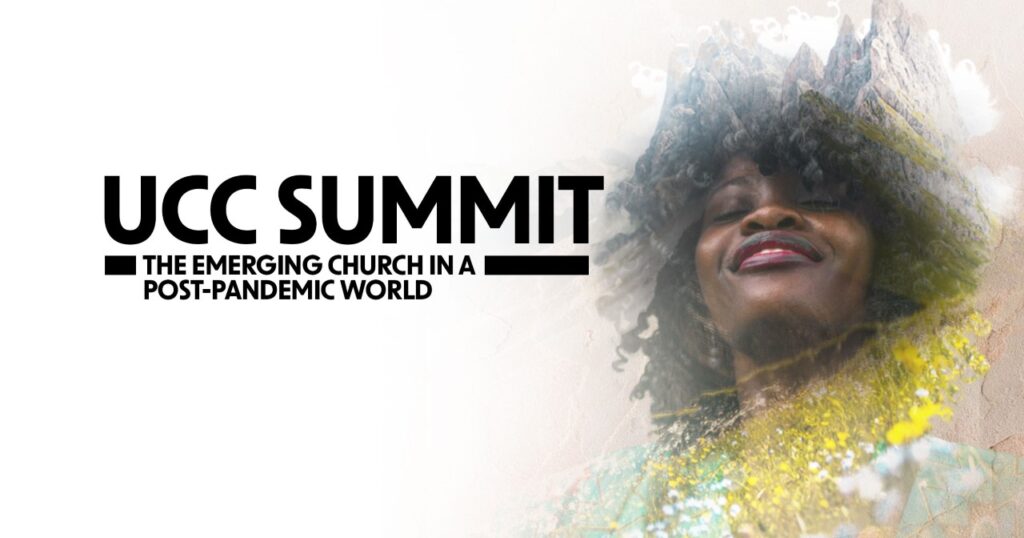Summit-goers consider how church might emerge from new realities, old struggles
Through the COVID-19 pandemic, churches have grappled with their purpose in a world undergoing a seismic shift.
Digging deep into the meaning behind the mission and ministry of local congregations — from bucolic one-church towns to justice-hungry urban streets — was the central work of the United Church of Christ’s virtual national summit, “The Space Between: The Emerging Church in a Post-Pandemic World.” The online event, Sept. 19-21, drew more than 150 participants.
Many of the questions and concerns they wrestled with are old. But the pandemic has injected them with new urgency:
- How to build community through authentic relationships — both online and onsite.
- How to incorporate technology into the most sacred spaces.
- Where to heal widespread trauma — sometimes caused by the church itself.
- How to do justice work.
- How to engage the community.
- Who is and isn’t a part of a faith community.
- And, above all, what it means to be church in this moment in history.
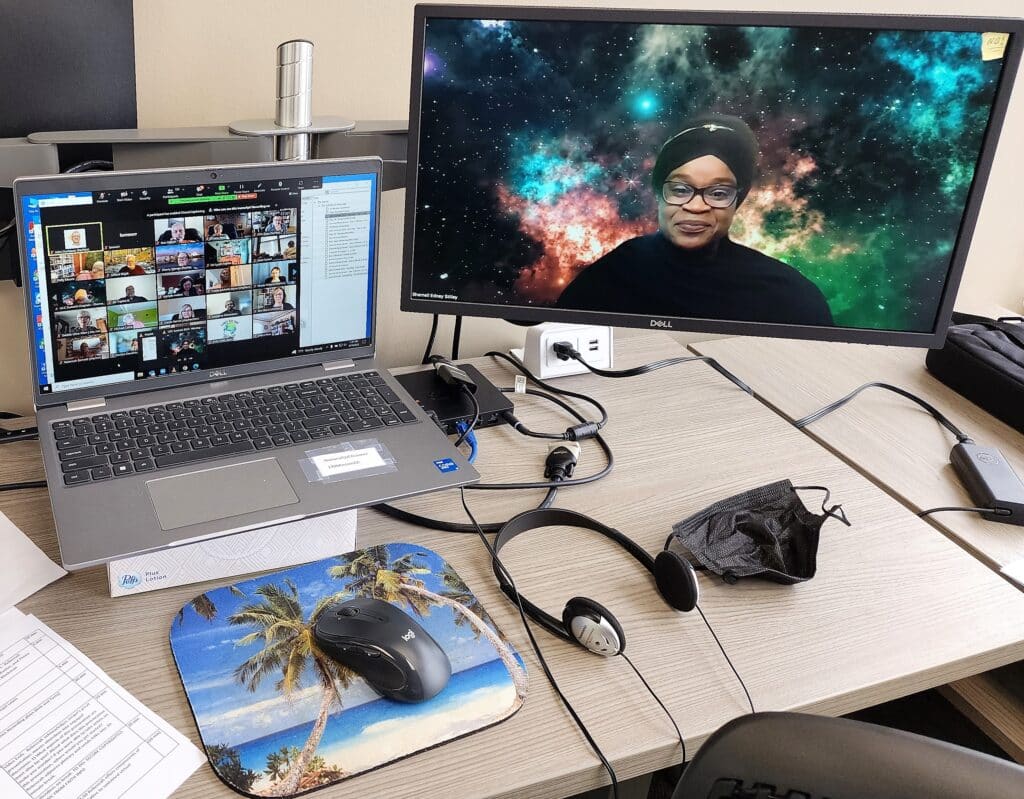
Preparing to ‘pivot’
“One of the questions of this week was, ‘What is here to stay?’” the Rev. Karen Georgia Thompson, associate general minister, told participants on the final day. “There is much that is here to stay.
“And the question is, for how long? How long do we hold onto this moment, and how do we prepare ourselves to pivot into what might come next?”
The summit, held via Zoom and Frontline Faith, explored many avenues. Prerecorded “provocateurs” let participants chew on profound theological challenges. Small-group breakout rooms contemplated real problems facing churches in a world of hybrid worship and online engagement. “Unpacking” sessions wove together threads of conversation into possibilities for the church’s future.
And in it all was an acknowledgement of the pain, the uncertainty and the hope that the pandemic has brought.
Resiliency and fragility
During the first day, participants shared what they believed churches had learned during the pandemic. In particular, they considered how COVID-19 revealed churches’ resiliency and fragility.
Participants answered on virtual sticky notes an online whiteboard program.
Here are some ways they described churches’ resiliency:
- “Our churches discovered capacity for change they didn’t know they had.”
- “The congregations who kept their children and youth through the pandemic were the ones who had already established strong relationships pre-pandemic.”
- “I have noticed that even the most senior and tech-shy folks can learn how to Zoom, and how to take ourselves off of mute.”
- “It took a village to get it to work.”
- “We had to embrace that God and the Holy Spirit does not live only within church walls.”
- “The congregations with a fierce determination to connect with and care for one another were more likely to think outside the box.”
- “The commute to Zoom church is really easy.”
And their fragility:
- “Rejection from sacred spaces is particularly difficult on people who have been traumatized by rejection from the church.”
- “The reality and depth of human loneliness — we still struggled to care for individuals alone at home who felt completely cut off.”
- “Rural churches lived through double challenge of poor internet connections and a wider community who often didn’t support COVID precautions (or reality).”
- “We need rituals to process grief.”
- “We are still struggling with the reality of many immuno-compromised folks who are still in a pandemic, and others who feel like it’s ‘over’ and we need to return to ‘normal.’”
- “Early on, the inability to visit people in-person also had a grave impact on clergy who were asking, ‘What is my job now?’”
- “There has to be an understanding that those who are worshiping through Zoom are not second-class members!”
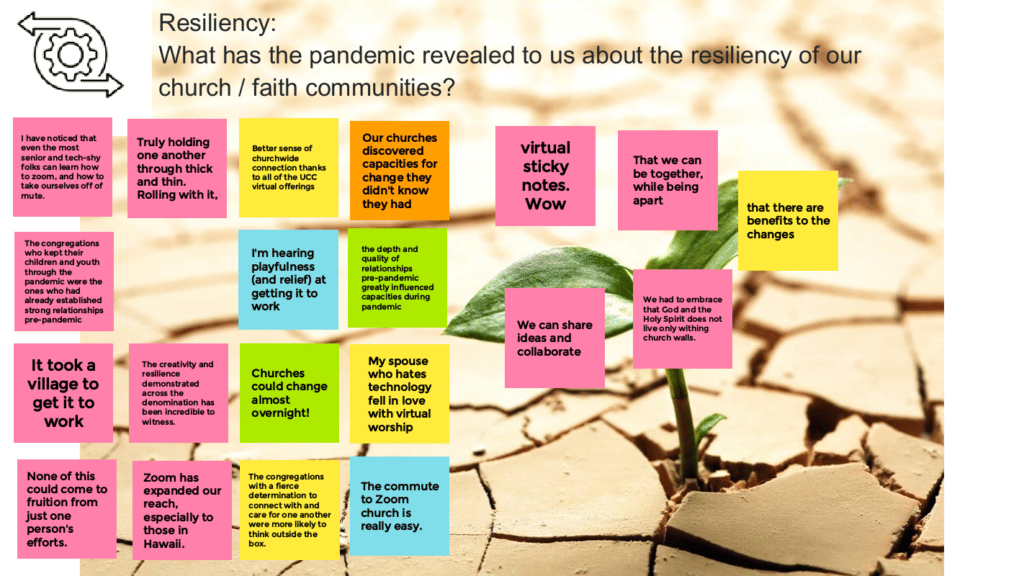
Hybrid church, sacred space
Breakout groups explored ways church has become a hybrid experience. On one hand, many longtime churchgoers still find their favorite pew for worship. On the other, people who may have never attended a church are participating in worship from their own homes. So how do churches integrate these communities in their full life and ministry?
Creating a sense of interactive participation in worship is “the greatest challenge for me, on both the user end and the organizing end, the planning end,” said the Rev. John Dorhauer, UCC general minister and president. “To create a hybrid experience where the online viewer doesn’t merely feel like an observer is a challenge,” he added.
The Rev. Phiwa Langeni, one of the summit facilitators, explained how church participation can be hybrid across not just space, but also time. Some viewers will watch recorded worship a day or a week or even a year or more in the future.
They also discussed the challenge of making hybrid spaces sacred for both those online and onsite, even if a church has the resources to obtain technology and run it. Inside a church, objects often may be considered holy, such as a baptismal font or communion table, Langeni said. Why not a livestream camera and its sacred accessibility?
“Instead of hiding technology, how do we show this is now part of the body of Christ?” they asked.
The Rev. Ian Lynch discussed how the main metric for measuring church participation is live worship attendance. But online and digital connection offers an opportunity to engage beyond the pews on a Sunday morning. “There are multiple ways of doing this,” he said.
Debbie Gline Allen shared advice she learned from Jason Moore: “Take a page from the NFL: they’ve been doing hybrid worship for decades.”
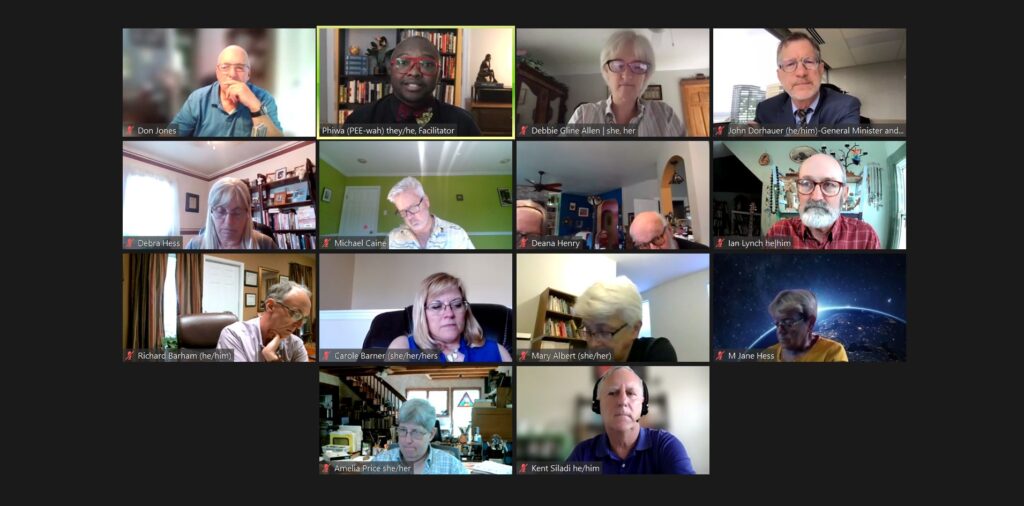
Relationships are key
Gline Allen stressed, however — as did many others — that relationship is the real key to navigating the integration of new and old worship spaces and members.
“Relationships are so key whether they are digital or in-person,” she said. “I think just taking the concept of relationship and infusing that in all your planning will help make both online and onsite worship and everything in between more meaningful.”
This was echoed throughout the summit by participants, provocateurs and presenters. It was one of the main lessons from this pandemic, participant Michele Mellott said: “Where are our relationships? And how are going to maintain those and grow those?”
‘Doing it scared’
The Rev. Traci Blackmon, UCC associate general minister, spoke during the second day about ways the church is changing and how that affects the relationship between church and community.
“Change can be frightening, as we heard yesterday,” she said. “… But here’s the thing: We can be fearful and faithful at the same time. It’s not faith if the outcome is known. So stop waiting for fear to dissipate. Because faith means doing it scared. And remember that even in the midst of some chaos, God still creates.”
Courage can be compassion, Blackmon said. And church is not the number of people who show up, but the impact it makes in a wider community. That’s how Blackmon described the church she sees emerging from this time.
“I see a church where relationship and empathy, listening, serving, are the essential elements of our being,” she said.
Others acknowledged the need to be open to change.
“The ‘sin of certainty,’” Shellie Brook wrote in the Zoom chat, in response to Blackmon using that phrase. “The unlearning before the transforming.”
Connection’s organic nature
Blackmon evoked the Pando tree, an interconnected colony of aspen that is considered the largest organism in the world. She asked summit attendees how church might be an interconnected organism instead of an organization.
Participants responded in the chat and live on Zoom during response sessions.
“I like the idea of thinking about church as organism rather than organization,” wrote the Rev. Jeff Spencer. “It makes sense to me if church is ‘the body of Christ’ that we think of church as organism.”
“Evolution is driven by the need to adapt to environmental change,” said the Rev. Gilford Bisjak. “We get to choose. Is the church evolving with spirit or dying for failure to adapt?”
“I was so, so very grateful to Traci Blackmon for her comments,” said the Rev. Mary Albert. “… For the emerging church to be authentic, we just need to be connected to that taproot.”
Technology, she added, is in service to our connection to God.
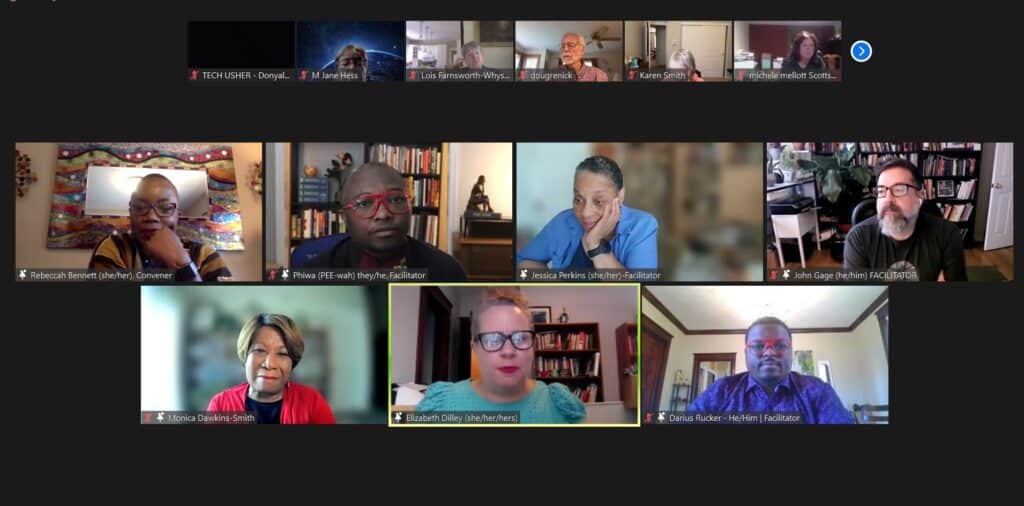
Need to ‘hyper-localize’
“One of the things I have been thinking about is that our own healing from the exhaustion is rooted in our solidarity with our communities who are also exhausted,” wrote Juan Carlos Huertas in the chat during Blackmon’s reflection.
Huertas, who serves on the staff of a UCC church in Lincoln, Neb., later led a small-group session, “Strategies for Solidarity.” He described the need to “hyper-localize” community-building work. “The imagination of solidarity, for me, is rooted in things like getting to know our literal neighbors,” he said.
Participants from Bethany Church, UCC, Randolph, Vt., joined via Zoom in a group around a single camera. One member talked about willingness. This included willingness to build relationships with neighbors, such as saying hello to a stranger in a grocery store, and willingness in “opening up to solidarity with people everywhere.”
The Rev. Molly Carlson shared a story about performing weddings at a small-town prison early in her pastoral career. She discussed the importance of accountability and “behavioral covenants” in supporting certain communities’ needs. “It doesn’t matter if you’re in a big city or a tiny town,” she said. “These opportunities exist.”
“And it’s our curiosity about that creates that opportunity,” Huertas said. “We have to be curious about our neighbors … and that doesn’t mean we are boundary-less.”
The Rev. David Hill shared his Ohio church’s experience engaging its local college community. He realized that the church couldn’t simply offer traditional programs and hope community members would show up. Instead, he explained, the church pivoted to asking: “What are they doing that intersects with what we’re doing?”
“What I’m hearing from the community (is), ‘How can we be in mutual ministry together?’” Hill said.
Membership in a changing world
Other small groups dug into the meaning of church membership. Questions about online-only church attendees got particular attention.
One of these groups was led by the Rev. Adam Ericksen, who described how his church set up worship to include online church members. “It allows us to have kind of a more intimate relationship with our online folk,” he said. “We’re up close on the screen, and it also allows us to have people help lead worship from throughout the country or throughout the world.”
He added that his church, physically located in an Oregon suburb, includes online attendees from Toronto and Michigan, among other places. And some of them aren’t traditional churchgoers.
“They have never entered into a church (or) they haven’t entered into a church building in years because of church trauma,” Ericksen said. “But they are perfectly happy to be in their living rooms and help lead worship for this church just outside of Portland. So it’s a way of bringing folks together who would never enter into a church room.”
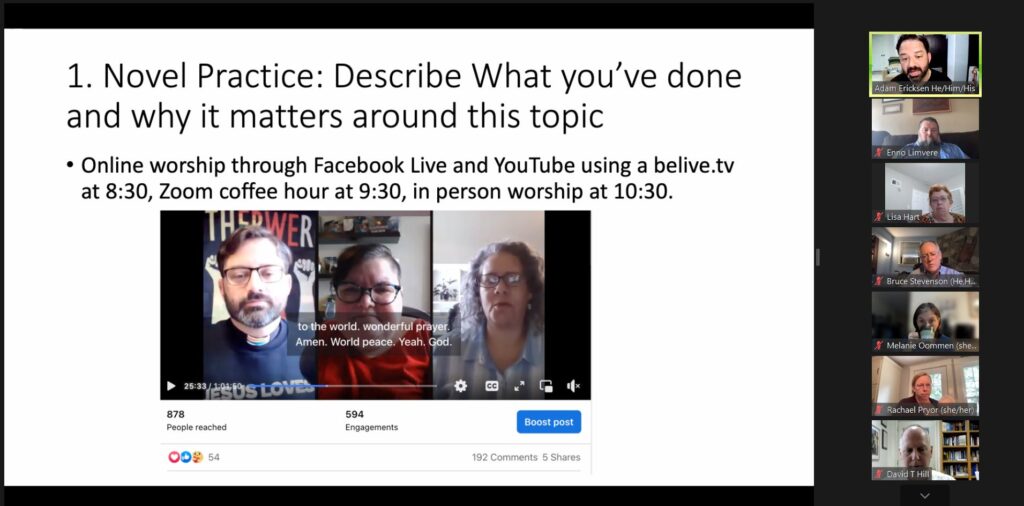
Trauma in churches, throughout lives
Trauma, whether church-caused or otherwise, was another topic explored in Zoom breakout rooms.
Jessica Perkins, one of the summit facilitators, shared thoughts from a group discussion on trauma. She noted the psychological weight that people have carried, both through the COVID pandemic and throughout their lives.
“We said the trauma was ubiquitous,” she said. “The grief was ubiquitous. In other words, all of us experienced trauma to some degree and grief to some degree.”
“As the climate crisis continues to unfold, the trauma and grief we experience directly and indirectly will continue to increase,” Spencer wrote in the chat.
Church as healer — or not
Rebeccah Bennett, the lead summit facilitator, expanded upon how faith communities can be spaces of healing — or hurting.
“Churches can be a place where people can be met in that trauma and supported in working through it, provided there is enough skill, enough relationship, enough community,” she said. “And also recognizing that church is a place where that trauma can happen.”
That is, Bennett added, churches can offer “deep and potent medicine,” and also “deep mess that needs to be addressed.”
“Church can also be a place where it is clearly NOT okay to share one’s trauma,” the Rev. John Gage, another summit facilitator, added in the chat.
Are we really ‘post’?
The question of what “post” means also came to the forefront.
“What a joy and blessing and struggle and challenge it is to be UCC,” the Rev. Michael Stephens said. He explained that the denomination is striving to be not just a “post-pandemic” church, but a “post-colonial” church.
Stephens was reacting to a presentation by the Rev. Damayanthi Niles, a professor at Eden Theological Seminary. Niles noted that “post” may not be the right framing.
“We will never be post-colonial any more than we will be post-pandemic,” she said. “… ‘Post’ means we’ve moved past the place we are.”
Maybe instead, she added, the church should strive to be “decolonized.” “De,” she said, means actively working to undo the harm wrought.
What will it look like?
The uncertainty of the term “post-pandemic” echoed throughout the summit.
“I confess that most days I am not even sure what we mean when we say ‘post-pandemic,’” Thompson said during the final day. “Are we talking about this moment? Is it five years from now? What will ‘post-pandemic’ look like?
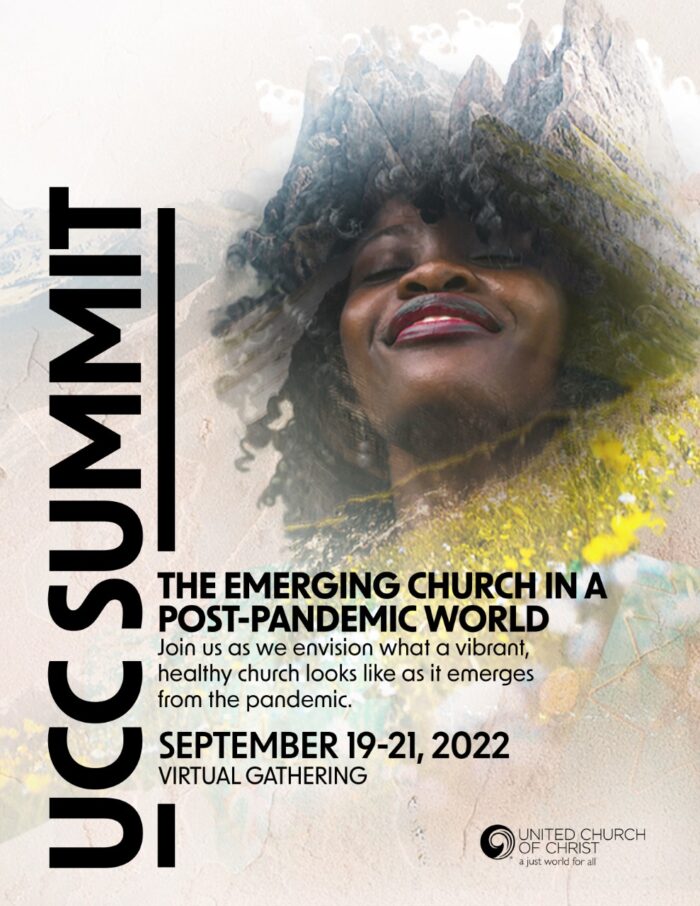
“Are we looking to a moment when the COVID-19 virus is gone? Are we pointing to a future where we see reduced deaths or no deaths at all? Do we see this post-pandemic future emerging among us?
“I believe, that as we talk about this post-pandemic church, that we are also talking about the church for the 21st century.”
Other highlights
The summit’s broad and deep offerings also included these:
- On the first day, the Rev. Jacqui Lewis charged progressive churches with the mission to “save Jesus” from rising tides of white supremacy and fascism.
- On the final day, the Rev. Laura Everett used a metaphor of knitting, unraveling and mending to discuss the process of lament, grief and healing experienced both before but especially during the pandemic.
- Other presenters included the Rev. Patrick Duggan, the Rev. Jamesetta Ferguson, the Rev. Michael Malcom, the Rev. Cameron Trimble and the Rev. David Vásquez-Levy.
Report-outs and materials from the summit will come in several forms, said UCC Chief Strategy Officer Cheryl Joseph Williams. No later than Sept. 30, people who registered for the event will get access to video recordings of talks by all nine presenters and of the music offered during the summit. They will also receive a “bundle” of PowerPoint documents containing material presented.
Later this fall, registrants will receive a final, long-form written report on the summit’s presentations and discussions. This will first be shared with the denomination’s leadership groups, such as the UCC Board and the Council of Conference Ministers, she said. An executive summary of that report will also be made available to the wider UCC public via the denomination’s website.
Content on ucc.org is copyrighted by the National Setting of the United Church of Christ and may be only shared according to the guidelines outlined here.
Related News
A Prophetic Call for Justice and Peace in Palestine
The executive leaders of the United Church of Christ have issued the following statement...
Read More‘Love is Greater Than Fear’: Regional Youth Events get to the heart of gospel message
United Church of Christ teens attending this summer’s Regional Youth Events (RYE) are...
Read MoreUCC desk calendars available to order now
Prepare for your day, month and year with the United Church of Christ desk calendar —...
Read More